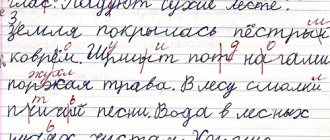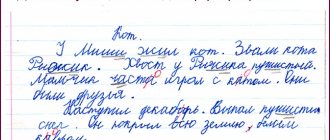Impaired written speech in younger schoolchildren
Currently, the problems of studying, diagnosing and correcting written speech disorders in children are among the most pressing tasks of pedagogy and speech therapy. This article analyzes the main reasons for the manifestation of persistent specific errors in the written work of primary schoolchildren, provides a classification of dysgraphia, and also describes the directions of correctional work with children with these disorders.
The problem of written speech disorders in schoolchildren is one of the most pressing for school education. About 40% of children from the total number of primary school students have one or another type of written language disorder (dysgraphia). Therefore, the problem of providing assistance to children with writing disorders remains urgent. In this regard, the purpose of this article is to comprehensively analyze the main disorders of written speech in primary schoolchildren.
So, the process of mastering written speech is in close interaction with the degree of formation of all aspects of oral speech: sound pronunciation, phonemic perception, lexical and grammatical aspects of speech, coherent speech. It follows that the cause of dysgraphia can be the same functional and organic disorders that cause oral speech disorders.
Also in the development of dysgraphia, one can note socio-psychological factors, such as a deficit of speech contacts, inattention to the child’s speech on the part of adults, unjustifiably early learning to read and write in the absence of a child’s psychological readiness, which contribute to the occurrence of disorders in the development of written speech.
The key to successful mastery of writing lies in a sufficiently high level of development of oral speech. But it is worth noting that, unlike oral speech, written speech can only develop under the condition of systematic and targeted training [1, p. 7].
The main sign of dysgraphia is typical and repeated errors in writing of a persistent nature, not related to ignorance of the rules and norms of the language. Such errors include: mixing and replacing graphically similar handwritten letters (sh-sch, t-sh, v-d, m-l) or phonetically similar sounds (b-p, d-t, g-k, sh- and); distortion of the letter-syllabic structure of a word (omissions, rearrangements, addition of letters and syllables); violation of the unity and separateness of the spelling of words; agrammatisms in writing (violation of inflection and agreement of words in a sentence). Children with dysgraphia have a low writing speed, difficult to distinguish handwriting, fluctuations in the height and inclination of letters, slipping from the line, etc. The presence of dysgraphia is diagnosed at the age of 8–9 years [4, p. 131].
Classification of dysgraphia is carried out on the basis of various criteria: taking into account impaired analyzers, undeveloped writing operations, and mental functions. Thus, the following types are distinguished:
- Articulatory-acoustic. These disorders are due to the fact that children pronounce sounds incorrectly, which means that when they pronounce them to themselves, they write them down incorrectly. To treat this type of dysgraphia, it is necessary to work on the correct pronunciation of sounds.
- Acoustic. Here children pronounce sounds correctly, but confuse them with similar sounds (voiceless-voiced: b-p, d-t, z-s; hissing: s-sh, z-z; and are also unable to distinguish the softness of individual sounds).
- Optical. Children with optical dysgraphia have difficulty writing and distinguishing letters: they add extra elements (sticks, lines, circles), skip the necessary ones, and can write in a mirror image in the opposite direction).
- Dysgraphia due to problems of language analysis and synthesis. Children with such a problem in writing may skip or repeat entire words, rearrange syllables and letters, write different words together (confuse prefixes and prepositions of nouns, attach part of the next word to one word, etc.).
- Agrammatic dysgraphia. Such violations are detected after grades 1–2, as they require greater knowledge of the rules of spelling words. This problem is due to the fact that children cannot correctly inflect words by gender and case, and cannot agree on an adjective and a noun (“good dog”, “beautiful field”, etc.). This problem can be observed in bilingual (bilingual) families, as well as when a child is taught in a non-native language [2, p. 56].
Overcoming dysgraphia requires coordinated work of a neurologist, speech therapist, teacher, child and his parents. Impaired written speech will not disappear on its own; mandatory work is required to eliminate this defect. In order to improve a child’s written speech, it is necessary to diagnose and fill gaps in the pronunciation of sounds, phonemic perception, develop the grammatical aspect of speech and expand the child’s vocabulary.
Dysgraphia correction classes include:
− work on correct articulation and reproduction of sounds;
− phonemic hearing training;
− analysis of sounds, as well as work on understanding the sound-letter composition of a word;
− writing training includes regular dictations, searching for letters indicated by the teacher in the text, word games, memorizing the spelling of letters;
− exercises for fine motor skills and improvement of interhemispheric connections also occupy an important place [3, p. 135].
All speech therapy classes are built with mandatory consideration of the child’s psychological characteristics, his speech development and the type of manifestations of dysgraphia. In addition, it is important to develop in the student a positive attitude towards work and the psychological component of speech, to stimulate him to study and achieve results.
Of course, an important place is given to the prevention of violations. Prevention of dysgraphia must begin in preschool age. Preventive work should include the targeted development of higher mental processes, spatial concepts, auditory and visual differentiation, and graphomotor skills. Timely correction of oral speech disorders is of great importance.
So, writing disorders (dysgraphia) in children of primary school age have been studied for a long time, but even now it is one of the most pressing problems in pedagogy and speech therapy, because dysgraphia is one of the most common forms of speech pathology in primary schoolchildren. Writing disorders affect the entire learning process and speech development of children. Timely identification of these disorders and precise determination of their pathogenesis in each individual case is extremely important for the development of speech therapy work with children.
Literature:
- Dubynina T. E. Causes of dysgraphia in younger schoolchildren // Modern psychology and pedagogy: problems and solutions: collection. Art. by mother XVII international scientific-practical conf. No. 12(16). — Novosibirsk: SibAK, 2021. — pp. 7–10.
- Kornev A. N. Dyslexia and dysgraphia in children. — 3rd ed. - St. Petersburg: Hippocrates, 2012. - 224 p.
- Melyukhanova E. E. Correction of dysgraphia in younger schoolchildren // Innovative science. - 2021. - No. 5. - P. 132–137.
- Sadovnikova I. N. Impairments in written speech and their overcoming in primary schoolchildren. - M., 1997. – 300 p.
Errors in writing by a schoolchild: how can a speech therapist help?
A child is six years old, starts school in a year, and adults still have to guess what he is saying? This, unfortunately, happens all the time. Many parents do not think about the fact that such a feature can seriously complicate the life of a future student.
What is speech?
Many today, trying to free up an invaluable half hour of silence, hand their child some gadget or interactive toy. The child is interested in them, he quickly gets carried away. Moreover, for the most part, it doesn’t even matter what kind of game he installs: an intellectual one, where he needs to think, or an entertaining one. The result will be the same: you don’t need to invent anything, conduct a dialogue for hares or dolls, or create the plot of the game - the application thinks for the child, and he just presses the buttons. Did not work out? "Try again!" Did it work out? "Keep it up!". The minimum set of words that a child hears while communicating with an electronic entertainer, and zero words spoken by the child himself during the game, will ultimately give parents silence not only here and now. Such a modern toy can lead to more serious problems later - difficulties with speech.
Oral speech is training. The muscles of the speech apparatus must be ready to pronounce certain sounds. The more often a small child says something to his parents and peers, the more his muscles are trained, which means the clearer the sounds sound. Provided, of course, that mom and dad and those around him do not have speech defects. A lack of communication in the family can also cause delayed speech development, and subsequently psycho-emotional development.
Speech is an indicator of a child’s intellectual development. There are known cases when, due to some tragic circumstances, infants ended up in the den of animals (wolves, panthers, dogs) and were fed by them. When these children were discovered and returned to human society, it turned out that they had the habits of the animal that fed them, and at the same time they did not have a formed thinking apparatus, did not have higher emotions, and it was impossible to teach them speech.
By learning to speak, a child not only gets the opportunity to explain what he needs here and now, but also develops his intellect and higher emotions, preparing the ground for successful schooling, creativity, etc. Speech is fully formed by the age of seven.
How does oral language affect literacy?
Speech therapist medical Yulia Ilyukhina says:
– By the age of seven, a child’s sound pronunciation, syllable structure, grammatical structure and connected speech are formed. Further, in the first grade, the child begins to develop a new skill - written speech. This is a more complex process for the psyche, the success of which is possible only with good mastery of oral language. If the child’s speech development is delayed, this means that written speech will also be impaired. It's like a weak foundation on which you can't build a good, strong house. Academic performance directly depends on the quality of written speech, not only in the Russian language, but also in other subjects, including oral.
When a child does not understand what he is reading about, misses sounds, calls them other sounds - this is a disorder of phonemic hearing. This is not a hearing problem; an ENT doctor will not help here. The child hears, but due to a violation of phonemic hearing, for example, the sound [m] his brain “remakes” it into the sound [n], and he writes “n”. To fix this, you need the help of a speech therapist. Ideally, it is better to eliminate this problem before the age of seven, so that the child at school no longer has such difficulties and learning proceeds easily.
At what age is it better to contact a speech therapist?
Of course, it is easier to teach when the process of speech formation is still underway than to reteach when it has already been formed. That is, if there are difficulties with speech and sound pronunciation, then it is optimal to address them before the school period.
– When speech has already been formed, it is more difficult for a child to adapt to correct pronunciation. The process of adaptation can be longer, and the load on the nervous system is more serious due to the fact that there is also a process of adaptation to school, a new environment and rules. And then there are classes with a speech therapist. Therefore, the optimal age is three to four years,” explained Yulia Sergeevna. – Classes with children are held in a playful way; children find it interesting during the “lessons”.
Why do speech disorders occur in children?
Difficult childbirth, hypoxia, taking antibiotics during pregnancy - all this can affect the child’s brain and lead to speech problems, for example, dysarthria. In this case, work on speech production is carried out not only by a speech therapist, but also by a neurologist.
– This problem occurs quite often today. But there is no need to be scared if the doctor makes such a diagnosis. It is relatively easy to eliminate, but in parallel with classes with a speech therapist, you need to take medications prescribed by a neurologist. They will support the child’s nervous system and create a launching pad for its development. You should not think that if a child has not started talking before the age of three, or speaks with difficulty, that he will “start talking later.” No, we need the help of specialists here,” says the speech therapist.
How long do you need to see a speech therapist?
Everything here is individual and depends on the overall development of the child.
If a child goes to first grade in September, there are no deviations and only the sounds [r] and [l] are missing, then over the summer they can be put in place. But here everything depends on the participation of the parents themselves in this process: correct and regular completion of homework will help you quickly master the technique of correct sound pronunciation. Tula, st. Sovetskaya, 67, office 2.1, tel..
PREFACE
The problem of violations of written speech is revealed in theoretical and practical aspects. The author introduces readers to the reasons for the occurrence of these disorders in schoolchildren, and proposes an original system of work to overcome impairments in written speech, taking into account modern requirements for the content of school education.
For speech therapists, Russian language teachers, students of defectology faculties and primary education faculties of pedagogical universities.
The problem of impaired writing in schoolchildren is one of the most pressing for school education, since writing and reading from the purpose of primary education turn into a means of further acquisition of knowledge by students.
The book reflects the results of many years of scientific and practical activity of the author, developing the problem of writing and reading disorders in relation to the population of students in secondary schools and, mainly, primary classes, because the main task of a school speech therapist is to promptly identify and overcome disorders of written speech, preventing their transition, complicating the educational and cognitive activity of students, to subsequent stages of education.
The first section of the book covers the prerequisites for the formation of writing and reading normally and the mechanisms of disorders leading to persistent specific errors in written speech; The revealed typology of such errors is illustrated by examples from student works. An original system for identifying and recording specific writing errors by a speech therapist is presented. The criteria for distinguishing dysgraphia from immaturity of writing skills, characteristic of the stage of literacy acquisition, are described. Diagnostic tasks are proposed to identify dysgraphia in students in grades 1–3. Materials from a comprehensive study of schoolchildren with dysgraphia are presented, characterizing the state of a number of their sensorimotor and gnostic functions that are important for the development of written speech.
The second section reveals a system of correctional education to overcome written language disorders - in four main areas. Each chapter is preceded by the necessary methodological commentary, defining the tasks and methods of organizing the proposed types of work. The range of topics, content and forms of work are determined by the specifics of speech therapy tasks, but at the same time they correlate with the key issues of the Russian language program in primary school.






